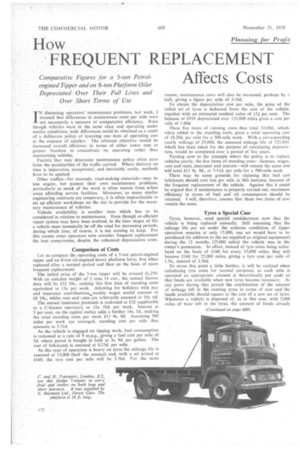FREQUENT REPLACEMENT Affects Costs
Page 66

If you've noticed an error in this article please click here to report it so we can fix it.
IN discussing operators' maintenance problems, last week, I stressed that differences in maintenance costs per mile were not necessarily a measure of comparative efficiency. Even though vehicles were in the same class and operating under similar conditions, wide differences could be obtained as a result of a deliberate policy of lowering one item of operating cost at the expense of another. The ultimate objective would be increased overall efficiency in terms of either lower cost or greater freedom to concentrate on operating rather than maintaining vehicles.
Factors that may determine maintenance policy often stem from the peculiarities of the traffic carried. Where delivery on time is imperative, exceptional, and inevitably costly, methods have to be applied.
Other traffics—for example, road-making materials—may be less urgent, but present their own maintenance problems, particularly as much of the work is often remote from urban areas affording service facilities. Moreover, as many similar engineering contracts are temporary, it is often impracticable to set up efficient workshops on the site to provide for the necessary maintenance of vehicles.
Vehicle availability is another item which has to be considered in relation to maintenance. Even though an efficient repair system may have been evolved, in the later stages of life a vehicle must necessarily be off the road for increasing periods, during .which time, of course, it is not earning its keep. For this reason some operators now consider frequent replacement the best compromise, despite the enhanced depreciation costs.
Comparison of Costs
Let us compare the operating costs of a 5-ton petrol-engined tipper and an 8-ton oil-engined heavy platform lorry, first when replaced after a normal period and then on the basis of more frequent replacement.
The initial price of the 5-ton tipper will be around £1,250. With an unladen weight of 2 tons 14 cwt., the annual licence duty will be £32 10s., making this first item of standing costs equivalent to 13s. per week. Allowing for holidays with pay and insurance contributions,..weekly wages would amount to £8 19s., whilst rent and rates are arbitrarily assessed at 10s. 6d.
The annual insurance premium is reckoned at £32 (applicable to a C-licence operator), or 12s. 10d. per week. Interest at 3 per cent, on the capital outlay adds a further 14s. 5d., making the total. standing costs per week £11 9s. 9d. Assuming 500 miles per week are averaged, standing cost per mile thus amounts to 5.51d.
As the vehicle is engaged -on tipping work, fuel consumption is reckoned at a rate of 9 m.p.g., giving a fuel cost per mile of 5d. where petrol is bought in bulk at 3s. 9d. per gallon. The cost of lubricants is assessed at 0.23d. per mite.
As this type of operation is heavy on tyres the mileage life is assessed at 15,000 (half the normal) and, with a set priced at £160, the tyre cost per mile will be 2.56d. For the same reason, maintenance costs will also be increased, perhaps by a half, giving a figure per mile of 3.10d.
To obtain the depreciation cost per mile, the price of the initial set of tyres is deducted from the cost of the vehicle, together with an estimated residual value of 12i per cent. The balance of £934 depreciated over 125,000 miles gives a cost per mile of 1.80d.
These five items of running costs thus total 12.69d., which. when added to the standing costs, gives a total operating cost of 18.20d. per mile for a 500-mile week. With a corresponding yearly mileage of 25,000, the assumed mileage life of 125,000.. which has been taken for the purpose of calculating depreciation, would be completed over a period of five years.
Turning now to the example where the policy is to replace vehicles yearly, the five items of standing costs—licences, wages. rent and rates, insurance and interest—will remain the same and will total £11 9s. 9d., or 5.51d. per mile for a 500-mile week.
There may be some grounds for claiming that fuel and lubricants should cost less per mile in this instance, because of the frequent replacement of the vehicle. Against this it could be argued that if maintenance is properly carried out, maximum efficiency in terms of fuel and oil consumption should be retained. 1 will, therefore, assume that these two items of cos! remain the same.
Tyres a Special Case Tyres, however, need special coniideration now that the vehicle is being replaced annually. Still assuming that the mileage life per set under the arduous conditions of tipper operation remains at only 15,000, one set would have to be purchased (in addition to the set supplied as original equipment) during the 12 months (25,000 miles) the vehicle was in the owner's possession. In effect, instead of tyre costs being calculated on the basis of £160 for every 15,000 miles, they will become £160 for 25,000 miles, giving a tyre cost per mile of 1.54., instead of 2.56d.
To stress this point a little further, it will be realized when calculating tyre costs for normal purposes, as each mile is operated an appropriate amount is theoretically put aside so that funds are available when new tyres become necessary. At any point during that period the combination of the amount of mileage left in the existing tyres in terms of cost and the funds available should equate to the cost of a new set of tyres. Whenever a vehicle is disposed of, as in this case, with 5,000 miles of wear left in the tyres, the amount of funds already












































































































